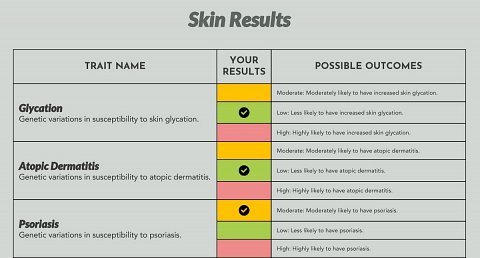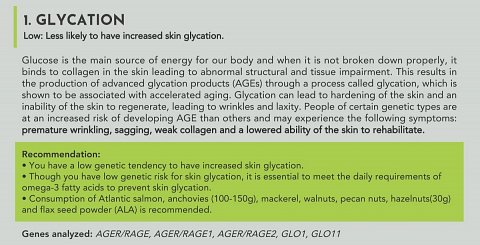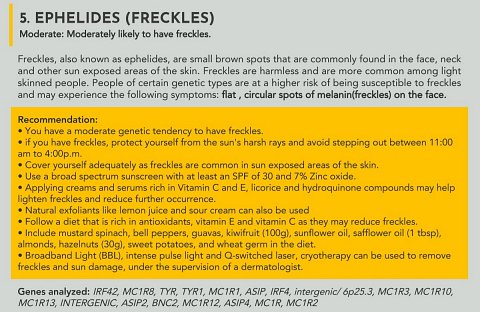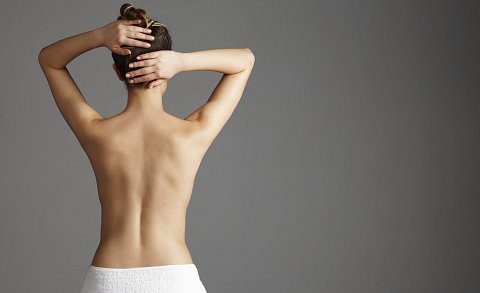-
Gene Skin
review on July 27, 2018
by Rebecca Fishwick

At a Glance
Summary
The ‘Gene Skin’ report by Xcode covered many areas of skin health and traits, and also the vitamins that contribute to maintaining skin health. I was given plenty of information about each result, including the genes that had been analyzed, and so I was able to do my own research if I wanted to find out more.
While the PDF format was a little basic, the report did cover a variety of areas, and also included plenty of nutrition recommendations, which were a helpful bonus, and would benefit my overall health as well as my skin.
Full Review
Xcode Life was founded in 2010 by C.E.O. Saleem Mohammed, C.T.O. Abdur Rub and Naru Narayanan, Head of Public Relations. The company is based in Chennai, India, and in 2014 was named ‘Most Promising Start-Up of the Year’ by Biospectrum. Mohammed and Rub each have several academic journals to their names, and the company specializes in preventative healthcare personalized using genomic data.
The tests offered by Xcode cover a variety of areas related to health, diet, nutrition, and genetic predispositions to disease. They accept raw genetic data from a number of providers, including 23andMe, MyHeritage, AncestryDNA and Family Tree DNA.
Product Expectations
I planned to take Xcode’s ‘Gene Skin’ test. On their website, the upload process seemed quite simple. First, I’d select my data format (23andMe, MyHeritage, etc.), then upload my data, after which I’d be able to view my report the same day.
Looking at the information for the Gene Skin test, it seemed that quite a bit of information would be included in my report. It would cover potential deficiencies for a number of vitamins, including various B vitamins, and vitamins A, C, D and K.
It would tell me how easily my skin tans and how good it is at protecting me from UV rays, and whether I am likely to develop sun spots, stretch marks or varicose veins. It would cover certain skin conditions, including atopic and contact dermatitis, psoriasis, rosacea, and acne.
I would learn whether I’m genetically prone to freckles, dry skin, or cellulite, and how well-protected my skin is against glycation – a process wherein glucose that hasn’t been broken down properly binds to the collagen in the skin. I would also learn how effective my body is at disposing of free radicals, and whether I require more antioxidants in my diet.
Ordering Experience
Ordering the test was very straightforward. First, I selected what sort of data I would upload (23andMe, in my case). I then selected the report I wished to download, which was Gene Skin. To pay, I needed to enter my name, email address, and a password. I also needed to agree to the Terms and Conditions, Privacy Policy and use of cookies, and so I took a look at their policies.
In the Terms and Conditions, I read that Xcode did not offer any diagnostic tools, and that they did not give any medical advice. In the Privacy Policy, I read that Xcode Life used cookies to collect marketing information (there were further details in their Cookie Policy, which was very transparent).
I also discovered that I could delete my raw data file at any time, and request a deletion of all my account information by emailing Xcode directly. My information would be used to conduct research projects only with my explicit consent.
Having read through their policies, I was happy to go ahead with my purchase.
I could pay with PayPal, Mastercard, Visa, Discover, or American Express. Once I’d bought the test, I was asked to upload my genetic data file, which I could simply drag into a box or locate on my device. They accepted txt, zip, csv, gz, and pdf formats. My file took less than a minute to upload.
I received an email telling me that my upload had been successful, and I would receive an email notification within 24 hours to say that my results were ready.
Within two hours, I received a notification that my report was ready.
The Results
I received an email with a link to log into my Xcode Life dashboard. From here, I went to “Orders”, where I saw that my report was ready. Clicking “View”, I found my PDF report in my file browser. I could download the report, or view it on the site.
The report began with an introduction, containing some information about why people have different skin colors (darker skin means more melanin, meaning more sun protection; lighter skin means better absorption of vitamin D), and some interesting facts about skin genetics.
There was also a guide to understanding the report. I read that they used the term “likely” when describing the impact of genes on various aspects of skin health, because there are many contributing factors apart from genetics.
My results would be indicated by a check mark, and the report would be color-coded for low, moderate or high risk. I could read a list of the academic papers they had used to reach my results on the Xcode blog.
Results Section: Skin Results
My results came first in an overview table, with tick boxes showing whether my risk of any particular condition or trait was low, moderate, or high.

A section from my Skin Results.
I thought this was quite a good at-a-glance overview, though at first I was worried that this was as in-depth as my results would get! “Low” risk was indicated in green, “Moderate” in orange, and “High” in red. I didn’t have any results for cellulite or dry skin, which I had seen were included in the report. I assumed this was because my 23andMe file lacked the genomic information needed for these results.
Results Section: Skin Traits
Scrolling down, I found that each of my results had been gone through individually in more depth.
I found I was unlikely to suffer from increased skin glycation (shown below).

My result for glycation.
I read that “glycation” is caused by glucose that hasn’t been broken down properly, which binds to collagen in the skin. This damages the skin, and causes accelerated aging and decreases the skin’s ability to regenerate.
To avoid glycation, it was recommended that I meet my daily requirements for omega-3 fatty acids, and they listed a number of foods that could help, including Atlantic salmon, anchovies, walnuts and flax seed.
They also listed the genes they had analyzed, though I wasn’t told which variants I had in these genes that had led to my results.
I also had a low likelihood of developing “atopic dermatitis”, more commonly known as eczema. This sounded about right, since I’ve never suffered from eczema!
My result for psoriasis was moderate risk, which was unsurprising, as a member of my family suffers from psoriasis, a skin condition that causes an increased production of skin cells, which results in patches of thick, flaky skin.
I was recommended a diet rich in vitamins D, E and B12, as well as omega-3, since these may help to prevent the condition. Foods they suggested included sunflower and safflower oil, almonds, hazelnuts, salmon, egg yolk and mussels.
Next, I found I was unlikely to have rosacea, a condition that causes red, inflamed skin on the face and neck.
I found I was moderately likely to have freckles, which I do, in moderation! I wasn’t sure why this was a “risk”, exactly, and I was confused by the assumption in the report that they were undesirable (shown below).

My result for freckles.
I found it odd that I was recommended to stay inside between 11am to 4pm, and not only to cover up but to use skin lightening products such as hydroquinone (banned in the EU) or lemon juice or sour cream to reduce the appearance of freckles.
I was recommended a diet high in antioxidants and vitamins E and C, which sounded like a good idea generally, and was told I could use light therapy or cryotherapy to remove freckles under the supervision of a dermatologist.
On the other hand, I was told I have a lower tendency to get sun spots, which was nice.
My result for tanning was a bit far off. I have untannable Irish skin, but my result told me I had a moderate likelihood for tanning (shown below).

My result for tanning.
I saw that they had analyzed a number of genes to achieve this result, and was confused about why my genes apparently didn’t reflect reality. Of course, it could be that certain genes or genetic variants affecting skin color and tanning haven’t been found yet. I doubted there were environmental factors involved, since lighter skin and little tendency for tanning runs in my family.
Unfortunately for me, I found I had a moderate risk for wrinkles and collagen degradation, meaning that the march of time would inevitably show on my skin. I read that skin aging could be accelerated by genetics, skin pigmentation, dehydration, UV exposure, smoking, and alcohol abuse.
I was recommended a diet high in antioxidants, including vitamins E and C, alpha-linoleic acids and omega-3. Foods I was recommended included guavas, blackcurrants, bell peppers, mackerel, salmon, and chia seeds. I was also recommended to wear sunscreen, and use creams and serums containing vitamins A, C and E and alpha-lipoic acid.
I also had a moderate risk for developing stretch marks, which I don’t have, and hope not to get anytime soon! Luckily, my result for developing varicose veins (swollen veins usually appearing on the backs of the legs) was low. I also found I was moderately likely to develop acne, which I had a little as a teenager, though never widespread or serious.
Results Section: Vitamin Deficiencies
My results for likelihoods of having vitamin deficiencies showed that I had a moderate risk for vitamin A deficiency (shown below).

My results for vitamin A.
I discovered that vitamin A is required for clear vision, healthy skin and good immunity. I could get vitamin A from my diet either in the form of retinol (from animal sources) or carotenes (from plants). I was recommended to eat carrots, sweet potato, leafy greens, milk, fish, and bell peppers.
I had a low risk for deficiency in vitamin B2, an antioxidant also called riboflavin, which plays a role in skin protection. However, I may be low in vitamin B6, which is needed for properly utilizing sugars, fats and proteins, and protects against glycation. My risk for B9 deficiency was low, and I read that B9 (also known as folate/folic acid) plays a major role in DNA synthesis and repair, and breaking down harmful homocysteine. B12 also helps to remove homocysteine, and my risk of deficiency of this was flagged as moderate.
My result for vitamin C was highlighted in red, meaning my risk of deficiency was high. I read that vitamin C is an important antioxidant and helps to boost immunity, and I was recommended to measure “serum vitamin C level”, presumably through a blood test. My food recommendations included cabbage, coriander, guava, green chilies, orange and broccoli.
I found I had a moderate risk of vitamin D deficiency, which I read is essential for the absorption of calcium, and for the immune system. I knew that we can get vitamin D from the sun; here, I learned that it is synthesized from cholesterol when we’re exposed to enough sunlight. I was recommended to eat calcium rich foods like chia seeds, beans, lentils, almonds, milk and eggs.
My results for vitamins E and K were also in the red. I read that vitamin E is an antioxidant that defends against free radical damage and prevents polyunsaturated fats from oxidizing. My recommendations included sunflower seeds, olive and wheat germ oil, spinach, avocados and shrimp.
Vitamin K I read played a role in blood clotting and preventing excessive bleeding. I was recommended to eat Brussel sprouts, cabbage, prunes, spring onion and leafy greens to boost my vitamin K levels.
There was also a result for “Antioxidant Needs”. I was moderately likely to require more antioxidants, which help to eliminate “free radicals” and prevent premature aging, tissue damage and chronic diseases. As it was likely I had a lower proficiency for defending against free radicals, it was recommended I have an antioxidant rich diet, including grapes, blueberries, nuts, leafy greens, sweet potato, carrots, whole grains, beans, and green tea.
Summary
The ‘Gene Skin’ report by Xcode covered many areas of skin health and traits, and also the vitamins that contribute to maintaining skin health. I was given plenty of information about each result, including the genes that had been analyzed, and so I was able to do my own research if I wanted to find out more.
While the PDF format was a little basic, the report did cover a variety of areas, and also included plenty of nutrition recommendations, which were a helpful bonus, and would benefit my overall health as well as my skin.


